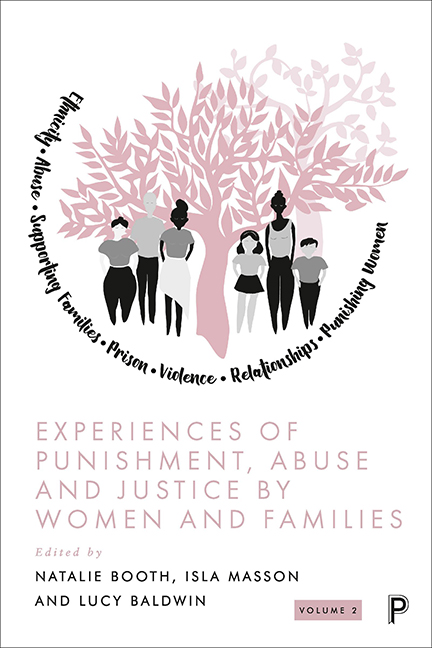Book contents
- Frontmatter
- Contents
- Notes on contributors
- Acknowledgements
- Foreword: time to shift the focus and reduce the use of the penal system for women
- 1 Keeping the conversation going: the Women, Family, Crime and Justice network
- Part I Punishing women in the criminal justice system
- Part II Violence, abuse and justice
- Index
6 - “Throwing the first punch before I got hurt”: the experiences of imprisoned women who have perpetrated intimate partner violence and abuse
Published online by Cambridge University Press: 18 January 2024
- Frontmatter
- Contents
- Notes on contributors
- Acknowledgements
- Foreword: time to shift the focus and reduce the use of the penal system for women
- 1 Keeping the conversation going: the Women, Family, Crime and Justice network
- Part I Punishing women in the criminal justice system
- Part II Violence, abuse and justice
- Index
Summary
Introduction
Understanding of intimate partner violence and abuse (IPVA) has steadily grown over recent decades, with public bodies across the globe now arguing that IPVA is a serious public health issue (NICE, 2014; CDC, 2020; WHO, 2021). Crime survey data in England and Wales show that in the year 2019–20, an estimated 2.1 per cent of men (513,000) and 4.9 per cent of women (1.195 million) had experienced non-sexual partner abuse (ONS, 2020a). This means that two in three victims of partner abuse are women, whereas one in three are men, with the majority of both women and men reporting the perpetrator to be of the opposite sex (ONS, 2020b). When incidents are reported and prosecuted in courts, of those convicted of an IPVA-related offence, 55,486 were men and 4,599 were women (in the year 2018–19; CPS, 2020). In the UK IPVA is not an offence in itself, as incidents are covered under existing criminal law, for example, assault or threats to kill. As such, there is no central collation of, for example, numbers of those serving prison sentences for IPVA-related offences. Thus, it is difficult to know just how many individuals are situated within the criminal justice system (CJS). Research on IPVA beyond prevalence data has focused on impact and consequences (Lagdon, Armour and Stringer, 2014; Sanz-Barbero, Barón and Vives-Cases, 2019), risk factors for perpetration (for example, Capaldi et al, 2012; Costa et al, 2015; Mackay et al, 2018) and interventions for both victims and perpetrators (for example, Stephens-Lewis et al, 2019; Trabold et al, 2020).
The plethora of research in the field has led to a narrative of IPVA that centres on a strong, domineering male perpetrator who is physically abusive to a female victim. However, more recently, there has been a burgeoning interest in male victims of IPVA as perpetrated by women, for example, exploring prevalence of victims (Nowinski and Bowen, 2012), impacts of IPVA on men (Hine, Bates and Wallace, 2020), barriers to accessing services (Wallace et al, 2019) and the demographic characteristics of male victims attending specialist support services (Hine et al, 2022).
- Type
- Chapter
- Information
- Experiences of Punishment, Abuse and Justice by Women and FamiliesVolume 2, pp. 91 - 109Publisher: Bristol University PressPrint publication year: 2023



